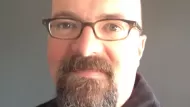I'm at the 18th Congress for the New Urbanism, always a stimulating affair and this year is no exception. We're in Atlanta, Georgia, although I've unfortunately not seen much of the city beyond a few leafy, upscale blocks past the anonymous section of downtown. Right now, I'm waiting for a session on "The Great American Grid" to begin, undoubtedly a topic of some interest to our readers considering the comments inspired by Fanis Grammenos' dismissal of America's grid worship.
I'm at the 18th Congress for the New Urbanism, always a stimulating affair and this year is no exception. We're in Atlanta, Georgia, although I've unfortunately not seen much of the city beyond a few leafy, upscale blocks past the anonymous section of downtown. Right now, I'm waiting for a session on "The Great American Grid" to begin, undoubtedly a topic of some interest to our readers considering the comments inspired by Fanis Grammenos' dismissal of America's grid worship.
The theme of this year's event is "New Urbanism: The Prescription for Public Places," and the relevance of the connection between health and the built environment was quickly and efficiently argued at Thursday morning's keynote. Howard Frumkin and Richard Jackson wrote a book called "Urban Sprawl and Public Health" six years ago, at a time when very few people were looking at the connection. Today, even the First Lady is talking about it. And no city embodies the connection more literally than Atlanta, where traffic accidents are the leading cause of death for Atlantans ages 3 to 33.
Larry Frank from the University of British Columbia illustrated how far research has come over the six years since Frumkin and Jackson's book, walking us through the new evidence connecting obesity and land use, how modern housing construction increases asthma and allergies, and the hidden health costs of transportation investment. Frank told a moving story of driving past an elderly woman suffering in the 95-degree heat on an unfriendly expressway and realizing that if she died the cause of death would be labeled "heat stroke" rather than "pedestrian-unfriendly design" or "Lack of transit options." In other words, we don't even know the full price of the effect land use decisions have on the humans who inhabit the built environment.
Truly data, not health, was the theme of CNU18. New Urbanism has long suffered from the lack of convincing arguments, and has been stereotyped as a field full of backwards-looking crackpots. Today, New Urbanists have not only a mounting collection of evidence at their fingertips but have brought GIS and data people on staff to make that argument project by project.
"Urbanism is political," said Peter Calthorpe, noted architect and author, in his presentation on climate change metrics. "There is a big obligation in the field of urbanism to change policy, and in order to do that you have to have metrics to show the benefits." Calthorpe has been creating places using New Urbanist principles in the challenging environment of California for decades now, and it was apparent that he sees these new tools for projecting the carbon emissions, health effects, and infrastructure costs of alternatives before they get built as a lifesaver. He wrapped up the session by saying, "Either we can make this case and win the policy changes we need, or good urbanism isn't going to happen."

Maui's Vacation Rental Debate Turns Ugly
Verbal attacks, misinformation campaigns and fistfights plague a high-stakes debate to convert thousands of vacation rentals into long-term housing.

Planetizen Federal Action Tracker
A weekly monitor of how Trump’s orders and actions are impacting planners and planning in America.

In Urban Planning, AI Prompting Could be the New Design Thinking
Creativity has long been key to great urban design. What if we see AI as our new creative partner?

King County Supportive Housing Program Offers Hope for Unhoused Residents
The county is taking a ‘Housing First’ approach that prioritizes getting people into housing, then offering wraparound supportive services.

Researchers Use AI to Get Clearer Picture of US Housing
Analysts are using artificial intelligence to supercharge their research by allowing them to comb through data faster. Though these AI tools can be error prone, they save time and housing researchers are optimistic about the future.

Making Shared Micromobility More Inclusive
Cities and shared mobility system operators can do more to include people with disabilities in planning and operations, per a new report.
Urban Design for Planners 1: Software Tools
This six-course series explores essential urban design concepts using open source software and equips planners with the tools they need to participate fully in the urban design process.
Planning for Universal Design
Learn the tools for implementing Universal Design in planning regulations.
planning NEXT
Appalachian Highlands Housing Partners
Mpact (founded as Rail~Volution)
City of Camden Redevelopment Agency
City of Astoria
City of Portland
City of Laramie



























